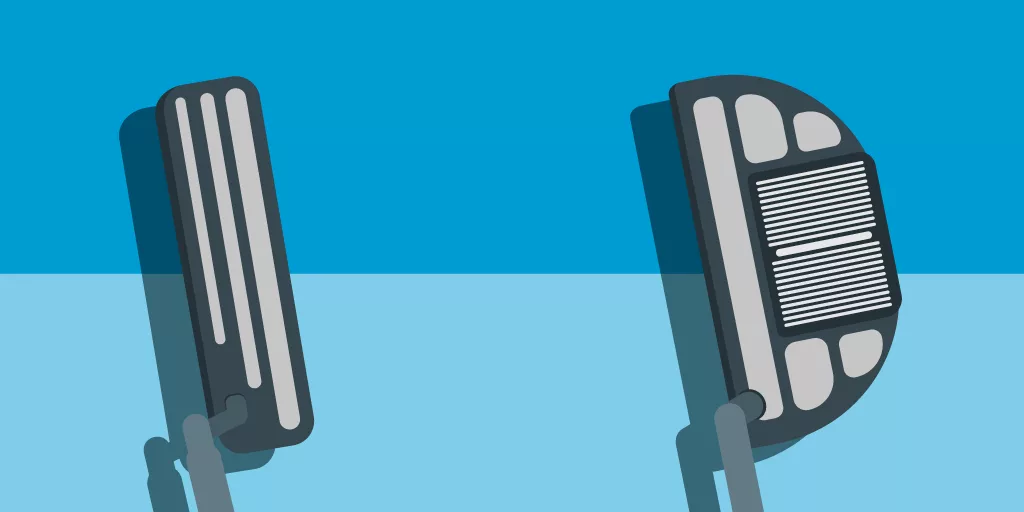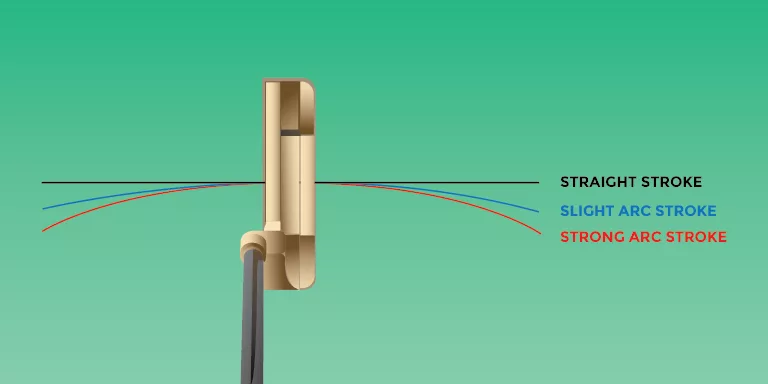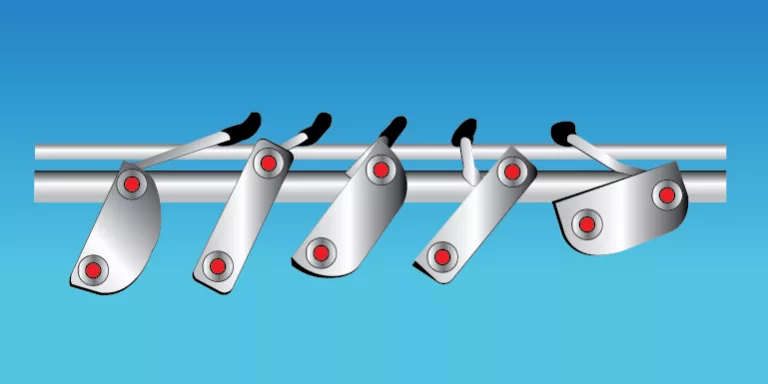
“Which style of putter should I buy, a blade or a mallet?” That’s a question that golfers have been asking for years.
In part, the decision is a personal one. Some golfers prefer looking down at the traditional, more minimalist design of a blade style, while others like the beefier profile of a mallet design. And aesthetics are important, to be sure. It’s tough to have a lot of confidence when using a putter that’s unappealing to your eye.
But other, more technical, considerations should also be considered when making that decision. Deciding on a putter solely based on how it looks is short-sighted and could possibly result in buying a putter that isn’t optimal for you. Those considerations include the amount of arc that naturally occurs in your stroke path, how the putter is “balanced,” the amount of “forgiveness” that a particular head offers, etc.
In this article, we’ll discuss these various factors in an easy-to-understand way so that, when you go into your local golf store or pro shop and face that intimidating display of dozens of putters, you’ll be more knowledgeable and better armed to pick the one that’s right for you.
So what are the issues that you need to be familiar with?
Your Personal Stroke Path is Key
Stroke path is defined as the actual route that your putter head takes, from your backswing to your follow-through, when you execute a putt. And it’s important to note that not everyone’s stroke path is the same. Your path is unique to you and happens naturally when you swing.
Some golfers have a stroke path that moves in a mostly straight line, both on the back swing and the through swing. This type of stroke path is referred to as “straight-back-and-through.”
Other golfers have a path that moves on an arc that mimics, on a miniature scale, what happens during a full swing. In this “arc stroke” path, the head moves slightly to the inside on the backswing, returns to square in the impact zone, and then moves slightly back to the inside on the through swing. Because it moves slightly “inward” on the backswing and forward swing, it’s also sometimes referred to as “inside-to-inside,” or simply “in-to-in.”

One is not better than the other. You can be an effective putter with either. As examples on the PGA Tour, Steve Stricker’s stroke path is an example of a “straight-back-and-through” style. On the other hand, Tiger Woods uses an arc stroke in his putting. But both are regarded as two of the best putters ever on Tour.
The mechanics of the two styles is not important at this point (that’s a discussion for another day). What is important, though, is that you identify which one you have.
Toe Hang? What’s That All About?
In addition to their outward appearance, what differentiates putters the most is how their balance point influences how the putter head naturally opens and closes during the stroke, irrespective of the golfer’s stroke path.
The technical term used to describe this concept is “toe hang.”
Toe hang refers to the direction in which the toe of the putter points if the putter is allowed to hang freely. To see if a putter has toe hang, and how much toe hang, take the putter and balance it lengthwise across your finger. In a putter with a lot of toe hang, the toe will hang down, angled toward the ground. Putters like this are said to be fully “toe balanced.”

Other putters will still exhibit some toe hang, but not quite as much. On these models with less toe hang, the toe will not hang directly down, but on more of a diagonal, to varying degrees based on the design of the putter.
Finally, with putters that have little or no toe hang, the face of the putter will point up to the sky. These putters are said to be “face balanced.”
What Do Stroke Path and Toe Hang Have to Do With Choosing a Putter?
Here’s why an understanding of these concepts is important in putter selection.
By design, a putter head with some amount of toe hang will naturally open and close during the putting stroke. This small face rotation may not be visible or noticeable to the naked eye, but it can be measured with sophisticated monitors. The amount of that opening and closing will depend on the amount of toe hang. More toe hang = more face rotation. Less toe hang = less face rotation.
Face-balanced putters, on the other hand, because they have little or no toe hang, will open and close very little during the stroke.
But here’s where the rubber meets the road when choosing a putter: what’s most critical is that the amount of toe hang on the putter needs to be in sync with the type of stroke path you have.
In other words, a golfer with a straight-back-and-through stroke path, where the putter head remains mostly on a straight line during the stroke, should be matched up with a putter design that similarly has little to no natural face rotation (i.e., a face-balanced model).
And conversely, a golfer that uses an arc stroke, in which the head follows a curved path, would do best to select a putter that likewise has a natural tendency to open and close during the stroke (i.e., a toe hang putter).
It’s not so true anymore, but, historically, blade-style putters were usually designed with toe hang, so golfers who used an arc stroke were advised to select a blade. Similarly, mallet putters were usually designed as face-balanced, so those with a straight-back-and-through stroke were advised to go with a mallet.
Today, however, putter technology has advanced to the point where you can now get both mallets and blades in either a face-balanced or a toe-hang style. Your selection of a mallet vs. a blade is no longer limited by the type of stroke path you employ.
Another Key Consideration: Forgiveness
It’s a safe bet that most amateur golfers are inconsistent with where they strike their putts on the putter face. Even with slow-speed swings like putts, amateurs will miss the sweet spot of the face a good portion of the time.
As you would expect, failing to make center-face contact can negatively affect how the ball rolls. When the face strikes the ball a bit toward the toe, for instance, it tends to twist or rotate open, while putts struck toward the heel will cause the face to twist closed. Putts that are mishit like this will often roll shorter than the intended distance, and will also tend to roll offline.
Fortunately, however, technology has come to the rescue. By strategically distributing weight both toward the head's perimeter and deeper toward the rear of the head, putter designers can increase the “forgiveness” of any putter. When using a putter designed like this, with forgiveness in mind, the head won’t twist as much when mishits occur, and the result will be a putt that rolls almost as far and as true as if the golfer had hit the sweet spot.
The term that describes this resistance to twisting is “Moment of Inertia,” or simply MOI. A putter with a high amount of MOI is very stable at impact, regardless of where the putt is struck on the face, and is therefore considered very forgiving. This is a desirable feature in putters, and amateurs should opt for putters with a high MOI when making their buying decision.
Do Mallets or Blades Have a Higher MOI?
Because a high MOI depends on the designer’s ability to strategically reposition weight around the head, mallet-style putters will almost always be more forgiving than blade-style putters. The larger profile of the mallet gives the designers more “real estate” with which to work, and they’re therefore able to create heads with a significantly higher MOI than their blade counterparts.
Some researchers have tested and confirmed the wide disparity in MOI between mallets and blades, showing that the MOI on some of the popular mallets (e.g., Ping Craz-E, Versa Jailbird) are as much as 25-50% greater than on the more popular blade styles (e.g., Newport 2, Ping Zing, etc.), and up to 70%greater on the ones with the highest MOI’s (e.g., Spider, Futura X, etc.).
When All’s Said and Done, It’s All About Face Angle at Impact
Ultimately, what you should be trying to do when you shop for a putter, is to find the one that has a natural rate of rotation that most closely matches the way you deliver the putter head to the ball, to create a 0° face angle at impact (as close to square as possible).
So in answer to the question as to whether a blade or a mallet is better, the answer is that it’s whichever one gives you the best face angle at impact.
You may prefer a particular model's look or brand name, but if that model doesn’t sync up with your stroke path and deliver a square face to the ball, you should put it back and continue your search.
How can you determine if the face angle is square at impact? The simple, but not the most scientific, way is to bring a ball with you on which you’ve drawn a straight line. Position the ball so that line is aimed directly at your target, and stroke some putts. If that line wobbles as it’s rolling, you know that the putter face wasn’t square at impact. If the line rolls purely, end-over-end, you know that the putter face was square when the ball was struck.
For those who want to get more scientific in your approach, you can buy a small monitoring device you can take with you when you shop for a putter (which you can also use on the putting green at your course or on the carpet at home when you practice). There are others, but one good one is called “Blast Motion,” and it’s a great tool to tell you exactly how much (in degrees) the putter face was either open or closed at impact.
Use a device like this when you’re shopping, and, rather than guessing, you’ll know precisely which putters are giving you the best face angles at impact.
Final Thoughts
As you can see, there are pros and cons to both blade and mallet putters. It ultimately comes down to your personal preferences, stroke, and style of play. Whether you opt for the classic look of a blade putter or the forgiveness of a mallet putter, the most important thing is to choose a putter that feels good in your hands and gives you confidence on the green. With the right putter in hand, you'll be on your way to sinking more putts and taking strokes off your game.
Frequently Asked Questions
Here are answers to commonly asked questions about blade versus mallet putters.